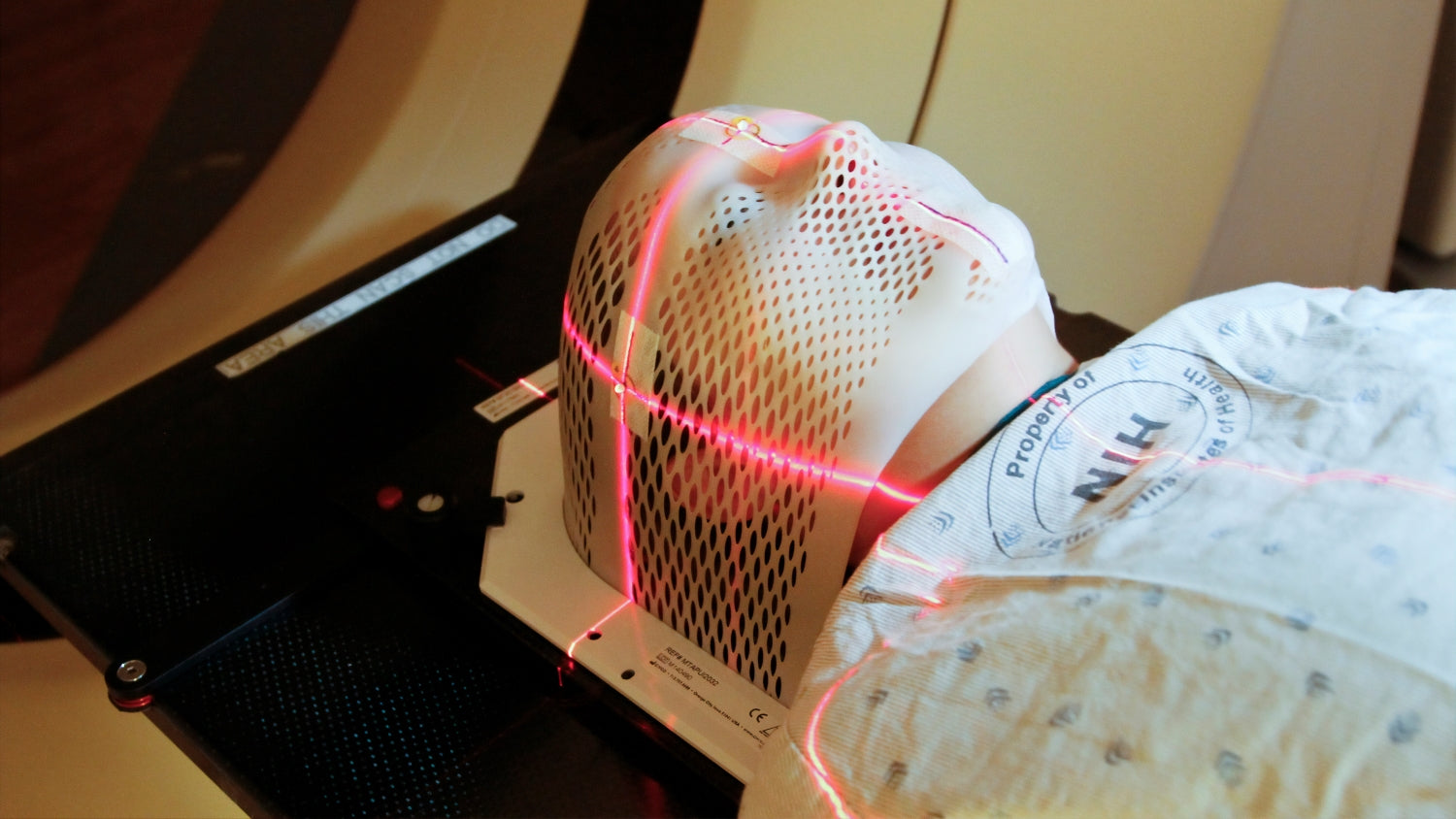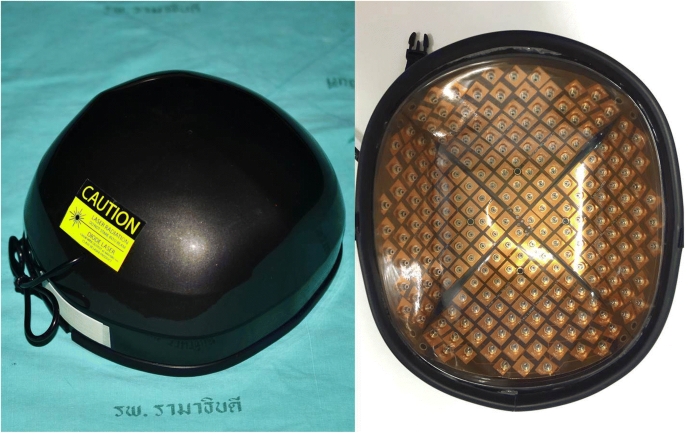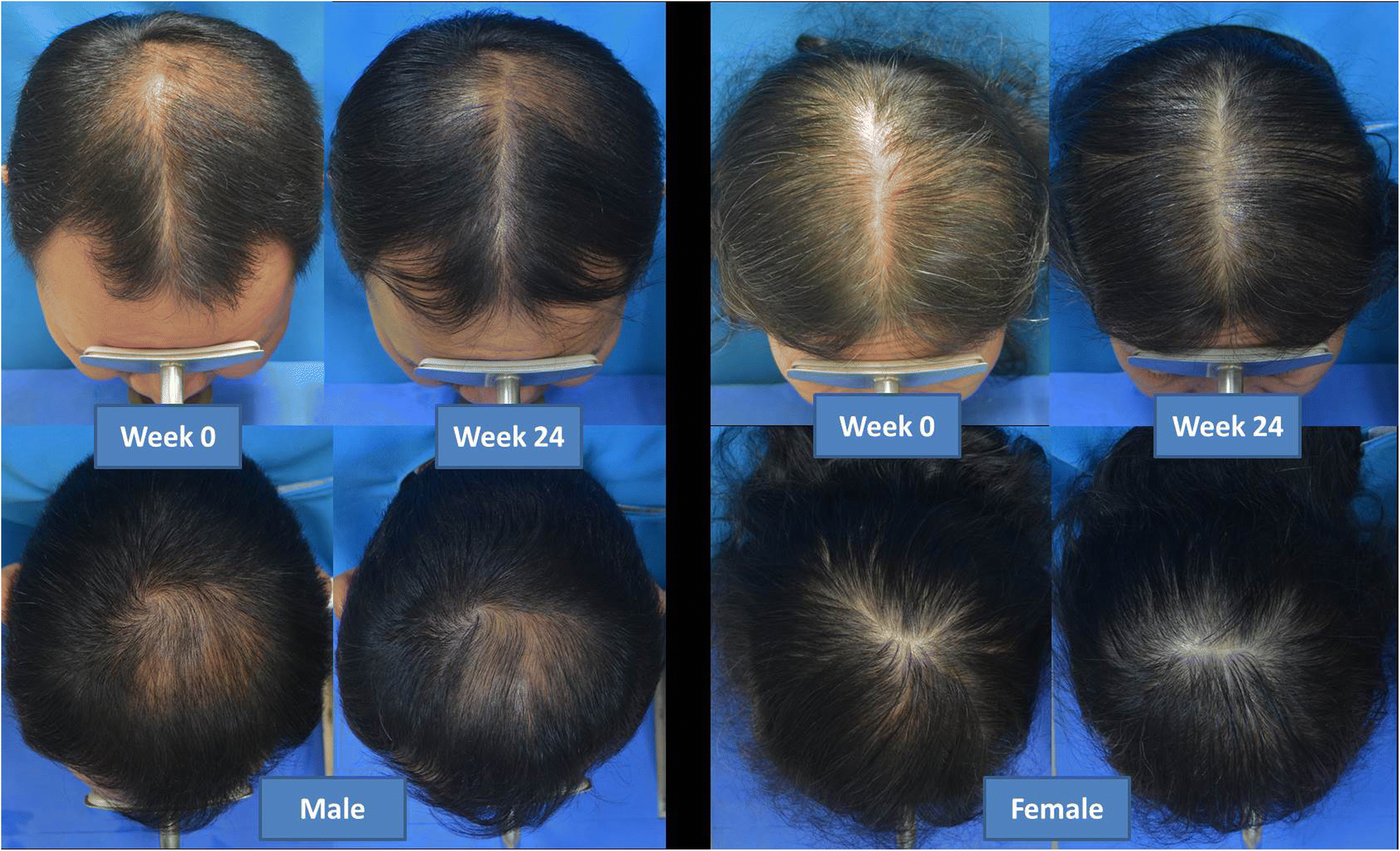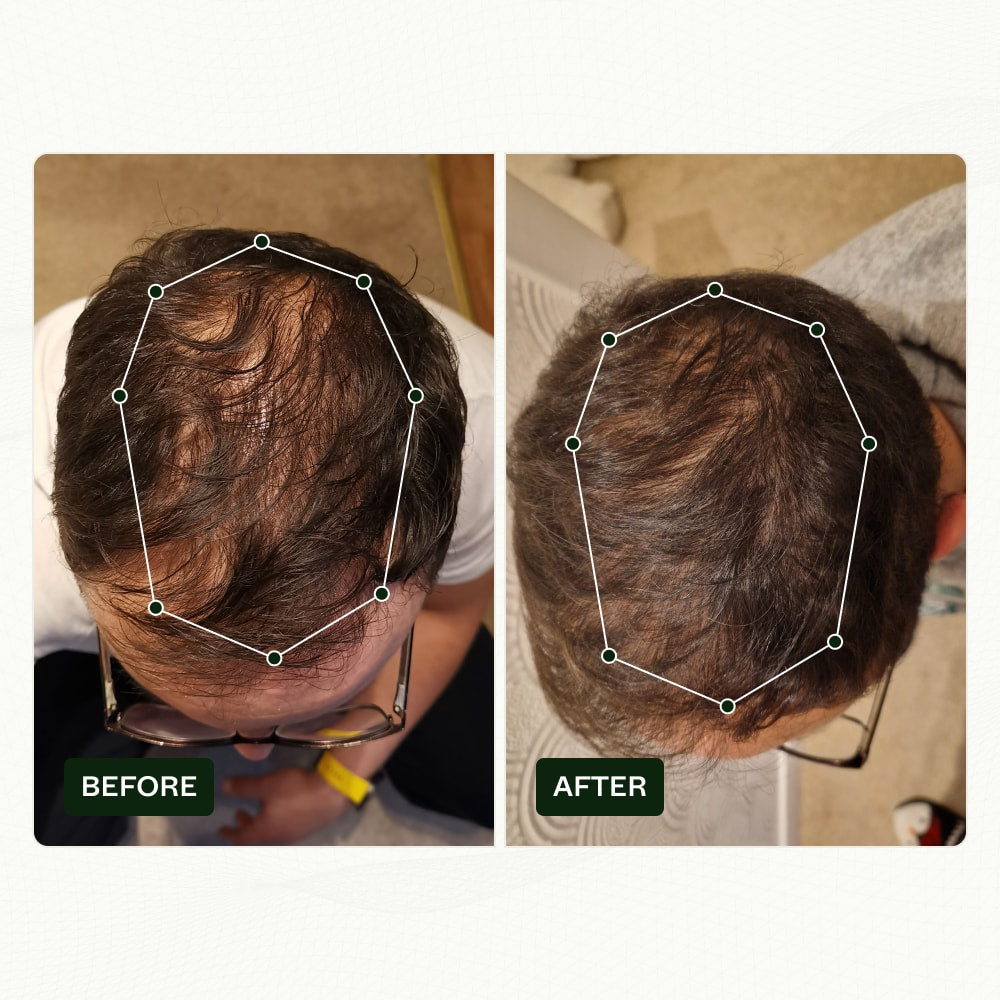Have you seen the buzz about red light therapy for hair loss online and wondered if it really works?
This non-invasive treatment uses specialized red and infrared light bulbs to stimulate hair growth from the comfort of your own home.
While it may seem too good to be true, recent studies show red light therapy can activate dormant hair follicles and boost circulation in the scalp. In this guide, we'll cut through the hype to review the science behind how it works and the real results people see.
Are these bright lights the solution to thinning hair or just false hope in a box? Dive in to find out.
Table of content
What is red light therapy for hair loss?

Red light therapy for hair loss involves treating thinning hair or balding scalp areas with low level light therapy (LLLT) devices that emit wavelengths of red or infrared light.
Red light therapy uses light in the 600-700nm range which is thought to increase cellular activity and stimulation of the hair follicles.
The therapy is safe and non-invasive.
While research is still ongoing, some studies have found it may help minimize hair thinning for those experiencing male pattern baldness, female pattern hair loss, or other types of alopecia when used over time.
It works as a complementary treatment to medical or surgical hair loss treatments.
As your leading source for hair health information over the past 4 years, we never compromise on accuracy. When it comes to your health, you deserve information you can truly rely on - and earning your trust is our top priority.
Here's how Scandinavian Biolabs ensures every piece of content meets the highest standards of accuracy and integrity:
- Credentialed Experts: Our reviewers are actively practicing doctors and medical researchers
- Stringent Reviews: Content undergoes rigorous editing by subject specialists and review by a practicing doctor.
- Evidence-Based: We rely on well-established research from trusted scientific sources like peer-reviewed journals and health authorities.
- Full Transparency: Our editorial standards, writer credentials, reviewer credentials, correction process, and funding are all publicly documented.
- Independent Voice: While we do promote products, we operate in a vacuum to business operations. Our main goal is just an unwavering commitment to providing medically-sound guidance.
You can count on Scandinavian Biolabs to consistently deliver the trustworthy health information you deserve. Read our Editorial Standards.
How does red light therapy for hair loss work?

Red light therapy for hair loss works by emitting wavelengths of light that stimulate cell growth. The light is absorbed by chromophores in the skin and converted to biochemical energy.
This nourishes hair follicles and promotes the hair growth phase (anagen phase) of the hair cycle by stimulating cell metabolism and increasing blood circulation and blood flow to the scalp. More nutrients and oxygen are delivered to hair follicles through improved circulation.
Studies show it can increase keratinocyte and melanocyte growth while reducing free radical damage. The low-level photosynthesis effect also promotes cellular energy and healing.
Does red light therapy work?
Red light therapy may help slow hair loss and encourage hair regrowth for pattern baldness. It is believed red light stimulates cellular activity to strengthen hair follicles and increase blood circulation to follicles, which can stimulate hair follicles to regrow hair.
A 2017 study of 47 women with early-stage female pattern baldness found that those who used a red light therapy helmet for 60 sessions at home experienced a 37% greater increase in hair growth compared to the placebo group.
Below is the before and after result from the study:

Another similar study from the same year involving 44 women with androgenetic alopecia found an even higher hair growth increase of 51% in the treatment group compared to placebo.
In a separate study, 44 men with different stages of male pattern baldness who received 60 home treatments with a red light therapy helmet saw their hair growth increase by 35% more than the placebo group.
A randomized, double-blind clinical trial from 2012 examined the effects of red light therapy on 40 subjects of both sexes with androgenetic alopecia. Results after 8, 16, and 24 weeks demonstrated significantly improved hair density and thickness in the treatment group following 24 weeks.
Here's the cap they used:

The before and after result of the study:

Multiple studies have found red light therapy to be effective at stimulating hair growth, as evidenced by the results above. While most research has focused on androgenetic alopecia, positive outcomes have also been reported for other hair loss conditions like alopecia areata and telogen effluvium.
How often should you use red light therapy?
Most experts recommend using red light therapy 2-3 times per week for it to be effective against pattern hair loss.
The standard protocol is to part the hair above the areas being treated and place the red light device about 2-5 inches from the scalp. Each session should last around 15-20 minutes in total, with the light directed to different sections of the scalp.
Studies have found using red light therapy less than twice a week is generally not enough to see results. The hair follicle cycle is about 28 days, so treatments spaced farther apart may not target the scalp at optimal times.
For best results, consistency is key. Red laser therapy may take 4-6 months of 2-3 times weekly use to start seeing benefits like healthier, thicker feeling hair and slowed shedding. Some people see improvements within 3 months but longer use is often recommended for more significant changes.
Taking treatment breaks is okay, but it's best to aim for low level laser therapy sessions at least twice per week on average over several months to give it time to work.
How long does it take for red light therapy to regrow hair?

Most research studies and dermatologists recommend using red light therapy at least 3 times a week for a minimum of 3 months to start seeing results in terms of hair growth.
During the initial 3 months of treatment, many people report seeing very subtle changes like a reduction in shedding or finer, thinner hairs sprouting up. After the 3 month mark, results tend to become more noticeable with thicker, darker hairs growing in areas previously affected by hair loss or thinning.
For maximum hair growth benefits, treatment is often continued for 6-12 months. Most people see approximately 30-40% hair growth of hair density after 6 months of regular red light therapy sessions. The full extent of potential hair regrowth may take 9-12 months to be realized in many cases.
Maintenance therapy is also commonly recommended, doing sessions 1-2 times per week long term to sustain the hair growth effects.
Is red light therapy for hair loss safe?
Red light therapy is generally considered very safe when used as directed. The lights emit low levels of red and infrared wavelengths that don't generate enough heat or energy to damage the scalp or hair follicles.
Some mild risks include temporary eye strain if looking directly at the light source. To prevent this, most devices feature a protective cover, or safety glasses can be worn.
Heat-sensitive individuals may experience mild warmth on the scalp during treatment but it does not elevate skin temperature dangerously. Proper ventilation and pausing between sections helps prevent overheating.
No significant side effects have been reported from red light therapy in numerous clinical studies involving hundreds of participants. On rare occasions, some experience temporary tingling, redness, or tenderness in treated areas that subsides quickly.
There are no known drug interactions making it safe to use alongside medications. However, those with implantable medical devices like pacemakers should check with their doctor first as a precaution.
How much does red light treatment cost?

The cost of red light therapy can vary depending on the device and treatment plan, but on average most will spend between $100-$600 initially for a home-use system. Clinics offer $50 to $150 plans.
- Budget options around $100-200 will be smaller, single-panel devices treating one section of the scalp at a time.
- Mid-range systems for $200-400 will be larger with multiple light panels to cover more area faster.
- High-end professional-use devices can exceed $600.
Some clinics also offer monthly red light therapy plans for $50-150+ depending on number/length of sessions.
Who should consider red light therapy for hair loss?
Red light therapy may be worth considering for mild to moderate hair loss where the cause is thought to be alopecia areata or pattern baldness/androgenetic alopecia.
Good candidates for red light treatment tend to be those who are experiencing noticeable thinning hair or shedding but have not reached an advanced stage of hair loss.
Does red light therapy hurt?

Red light therapy is generally a painless and comfortable treatment. The lights used emit longer, non-thermal wavelengths of red and near-infrared light that penetrate the scalp harmlessly. Individuals experience no heat, pain, or sensitization during typical at-home red light sessions.
Some may feel a slight warming sensation on the scalp area being treated, similar to leaning close to a low-watt light bulb. This is normal and not painful. Rarely, very sensitive individuals may perceive the warmth as mildly uncomfortable but it is not a burning sensation.
Proper technique such as using the recommended duration and keeping a safe distance from the light source helps ensure a safe, pain-free experience.
Well-designed consumer red light therapy devices have cooling features to prevent any potential heat buildup on the scalp.
How to choose the best red light therapy device at home?

Here are the key factors to consider when choosing the best red light therapy device for at-home use, in a succinct yet detailed manner:
Wavelength
Select a device with red and near-infrared LEDs between 600-1000nm, as these have the most research backing their efficacy.
Intensity
Aim for 30-50mW/cm2 of effective power output. Stronger isn't necessarily better.
Panel Size
The larger the area it treats at once, the faster sessions will go. But portability is also a factor.
Timer
An auto-shutoff timer between 3-15 minutes per session allows for consistent use.
Ease of Use
Consider battery life, lightweight design, and simple controls for stress-free daily use.
Regulatory Compliance
Look for FDA/CE marking indicating safety testing has been done. This provides peace of mind.
Price
Costs vary significantly but highly effective devices start from $150-300 range. Cheaper options may lack features for best results.
Brand
Choosing a device from a reputable brand with excellent reviews that ticks all the above boxes will help maximize the potential benefits of red light therapy for hair regrowth at home.
Starting with a budget option like a laser cap allows upgrading later if desired.
What to use with red light therapy?

While red light therapy (RLT) has emerged as a promising tool in stimulating hair growth by enhancing cellular activity and increasing blood flow to the scalp, pairing it with the right topical solution can significantly amplify your results.
Enter Bio-Pilixin Serum, a scientifically formulated solution that works seamlessly with RLT or serves as a potent standalone serum in your hair care regimen.

Here's why Bio-Pilixin Serum is the complementary choice and alternative you've been seeking:
- Enhanced Follicular Strength: Bio-Pilixin Serum targets the hair follicles directly, nourishing them with essential nutrients to support and strengthen your hair from the root, thus maximizing the effects of RLT.
- Natural Growth Activation: Infused with a blend of natural ingredients, the serum works to stimulate the hair growth cycle, promoting denser, thicker hair. This makes it a perfect ally or alternative to RLT, especially for those seeking an all-encompassing approach to hair loss.
- Scientifically Tested Results: With a commitment to results backed by science, Bio-Pilixin Serum has undergone rigorous testing to ensure its efficacy. This means you're not just trying another hair care product; you're investing in a solution proven to combat hair thinning and loss.
- Seamless Integration: Whether you choose to incorporate Bio-Pilixin Serum into your RLT routine or use it as your primary treatment, its easy application and fast-absorbing formula ensure it fits effortlessly into your daily hair care regimen without any hassle.
- Safety and Assurance: Understanding the sensitivity of hair loss treatments, Bio-Pilixin Serum is formulated with your safety in mind. It's gentle yet effective, making it suitable for all hair types and compatible with red light therapy, without any known adverse interactions.
As you continue to explore the potential of red light therapy for hair loss, consider how Bio-Pilixin Serum can elevate your efforts.
Whether used in tandem with RLT or as a powerful standalone treatment, Bio-Pilixin Serum offers a scientifically supported, effective route to achieving the fuller, healthier hair you desire.
FAQs
Can you combine red light therapy with other hair growth products?
Red light therapy can be used alongside topical treatments like Bio-Pilixin serum, minoxidil, or finasteride. It's generally recommended to apply topical treatments after red light sessions to ensure maximum scalp penetration.
However, specific integration into a treatment plan should be discussed with a healthcare provider to tailor the approach based on individual needs and potential interactions.
Are there any long-term studies on red light therapy for hair loss?
Current research supports the short-term efficacy and safety of red light therapy for hair loss, but long-term studies are less common.
The sustainability of results and long-term side effects remain under-researched areas.
Continuous monitoring and follow-up studies are needed to fully understand the long-term implications of red light therapy.
How does red light therapy compare to PRP or dermarolling?
Red light therapy is considered less invasive and generally safer than other non-surgical treatments like PRP therapy or scalp microneedling (dermarolling), which may cause discomfort or require downtime.
However, the effectiveness can vary, with some individuals responding better to PRP or microneedling. However, derma rolling is a cheaper option that's well-studied.
The choice between these treatments often depends on individual cases, preferences, and the recommendation of a healthcare professional.
Conclusion
If you're looking for an effective hair loss treatment to use in combination with other products then by all means LED light therapy is for you.
However, if you're only looking to use one method to improve your hair thickness, hair count and potentially get rid of androgenic alopecia, you might have to keep looking.
Bio-Pilixin, minoxidil, and finasteride are all great hair growth alternatives to use with red light treatment.
Or, a hair transplant surgery option is a good last resort too if you have severe pattern hair loss or androgenetic alopecia.
References
- https://www.ncbi.nlm.nih.gov/pmc/articles/PMC3986893/
- https://www.ncbi.nlm.nih.gov/pmc/articles/PMC3944668/
- https://www.ncbi.nlm.nih.gov/pmc/articles/PMC4265291/
- Freedom Laser Therapy
- Ziering Medical
Read more







